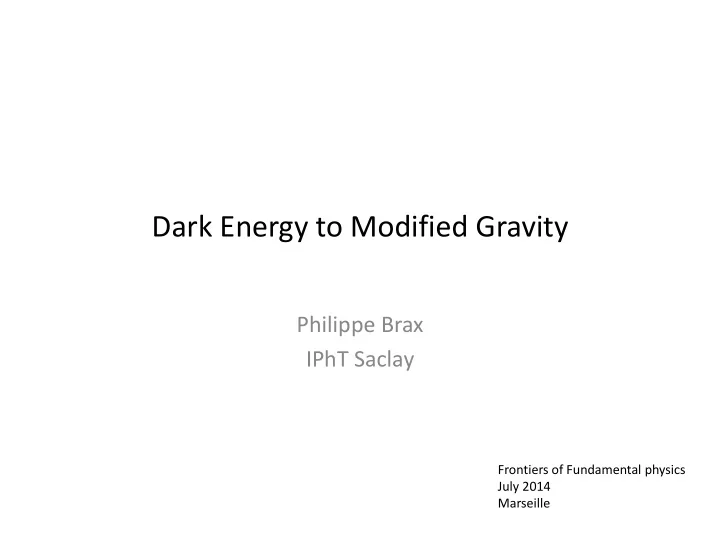

Dark Energy to Modified Gravity Philippe Brax IPhT Saclay Frontiers of Fundamental physics July 2014 Marseille
The Big Puzzle
Acceleration of the expansion Dark Energy ? Modified gravity on large enough scales?
Acceleration of the expansion Dark Energy ?
Acceleration of the expansion Modified gravity on large enough scales? Large scale structures
One may try to modify the effective equations of gravity on linear scales: Two Newtonian potentials related by: And a modification of the Poisson equation and Newton’s law : Leading to a modification of the linear growth equation:
EUCLID Forecast f ( ) z Equation of state g m Growth index Model independent parameterisation valid on linear scales only.
GRAVITY ACTS ON ALL SCALES! Nothing guarantees that a modification of gravity on large scales is consistent with the gravity tests in the solar system.
Acceleration of the expansion Modified gravity on large enough scales. Potential energy leads to dark energy. Massive graviton always involves a scalar field. Parameterised by a scalar field ϕ Modified Dark Gravity Energy
For these ubiquitous scalars: very low masses
For these ubiquitous scalars: very low masses Major gravitational problem!
Deviations from Newton’s law are parametrised by: For large range forces with large λ , the tightest constraint on the coupling β comes from the Cassini probe measuring the Shapiro effect (time delay): Bertotti et al. (2004)
A large class of modified gravity models:
f(R) is totally equivalent to an effective field theory with gravity and scalars! The potential V is directly related to f(R) Crucial coupling between matter and the scalar field
Are these models completely ruled out?
SCREENING
SCREENING Mechanisms whereby nearly massless scalars evade local gravitational tests
Around a background configuration and in the presence of matter, the Lagrangian can be linearised and the main screening mechanisms can be schematically distinguished : The Vainshtein mechanism reduces the coupling by increasing Z
Around a background configuration and in the presence of matter, the Lagrangian can be linearised and the main screening mechanisms can be schematically distinguished : The Damour-Polyakov mechanism reduces the coupling β
Around a background configuration and in the presence of matter, the Lagrangian can be linearised and the main screening mechanisms can be schematically distinguished : The chameleon mechanism increases the mass.
The Vainshtein and K-mouflage mechanisms can be nicely understood: Effective Newtonian potential: For theories with second order eom: Vainshtein K-mouflage
Vainshtein Newtonian gravity retrieved when the curvature is large enough: On large cosmological scales, this tells us that overdensities such as galaxy clusters are screened : On small scales (solar system, galaxies) screening only occurs within the Vainshtein radius:
K-mouflage Newtonian gravity retrieved when the gravitational acceleration is large enough: On large cosmological scales, this tells us that overdensities such as galaxy clusters are not screened : On small scales (solar system, galaxies) screening only occurs within the K-mouflage radius: Dwarf galaxies are not screened.
Chameleons: The screening criterion for an object BLUE embedded in a larger region RED expresses the fact that the Newtonian potential of an object must be larger than the variation of the field: Scalar charge: Self screening: large Newton potential Blanket screening: due to the environment G Newton’s potential at the surface
The effect of the environment When coupled to matter, scalar fields have a matter dependent effective potential Environment dependent minimum The field generated from deep inside is Yukawa suppressed. Only a thin shell radiates outside the body. Hence suppressed scalar contribution to the fifth force. Chameleon
All these models can be entirely characterised by 2 time dependent functions. The non-linear potential and coupling of the model can be reconstructed using: tomography
C The Milky Way must be screened If not effects on the dynamics of satellite galaxies : The environment C is the cosmological background if the local cluster is not screened. It is the local cluster if it is screened . This gives a bound depending on the mass and coupling Self screening Blanket screening
Self-screening of the Milky Way : This bounds the range of the scalar interaction to be less than a few Mpc’s on cosmological scales
Due to the scalar interaction, within the Compton wavelength of the scalar field, the inertial and gravitational masses differ for screened objects: VIOLATION OF THE STRONG EQUIVALENCE PRINCIPLE B A C
The Lunar Ranging constraint becomes: This leads to a tight bound on the range: Large curvature f(R): for n>1 the Milky Way condition is the strongest.
Big Bang Nucleosynthesis tells us that particle masses should not vary more than 10% between BBN and now. This is realised provided that: The field follows the minimum of the effective potential since BBN. The mass is always much larger than the Hubble rate m>>H The equation of states varies very little from the concordance model: At the background level, these models are indistinguishable from Λ -CDM.
At the linear level, CDM perturbations grow differently from GR: Inside the Compton wavelength k<<m(a)a, anomalous growth depending on the coupling to matter β (a). Outside the Compton wavelength, growth is not modified: Inside the Compton wavelength, more growth:
Modification of gravity on quasi-linear to non-linear scales N-body simulations: ECOSMOG simulations using a modification of the RAMSES code.
Summary Dark Energy/Modified gravity requires low mass fields, and therefore fifth force problems Cured by screening mechanisms: Chameleon, Damour-Polyakov or Vainshtein Strong constraints on the interaction range leading to implication on quasi-linear structures of the Universe
Recommend
More recommend